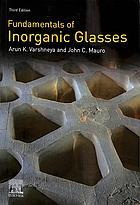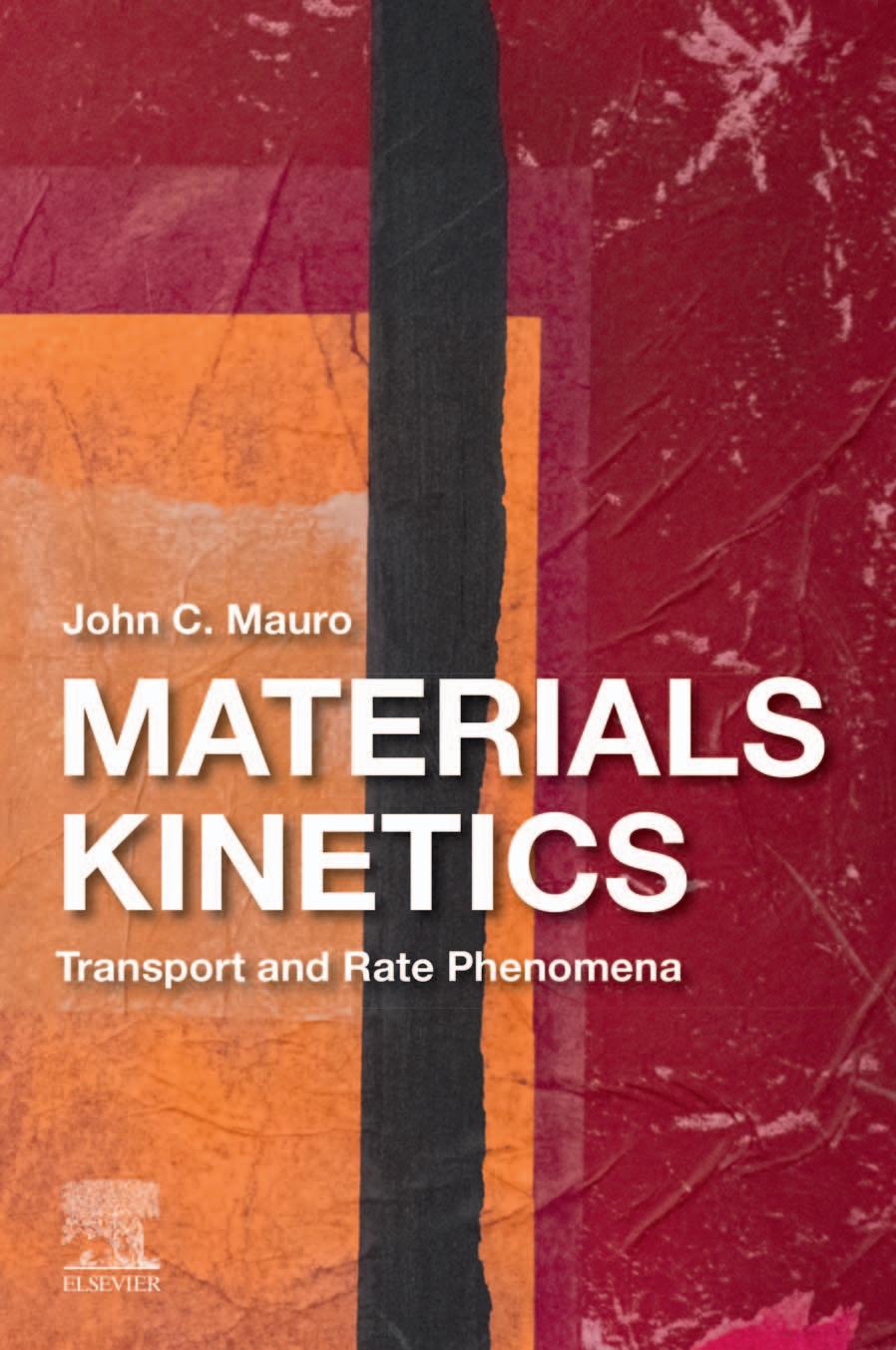MATERIALS KINETICS TransportandRatePhenomena
JOHNC.MAURO
ThePennsylvaniaStateUniversity UniversityPark,Pennsylvania
Radarweg29,POBox211,1000AEAmsterdam,Netherlands TheBoulevard,LangfordLane,Kidlington,OxfordOX51GB,UnitedKingdom 50HampshireStreet,5thFloor,Cambridge,MA02139,UnitedStates
Copyright©2021ElsevierInc.Allrightsreserved.
Nopartofthispublicationmaybereproducedortransmittedinanyformorbyanymeans, electronicormechanical,includingphotocopying,recording,oranyinformationstorageand retrievalsystem,withoutpermissioninwritingfromthepublisher.Detailsonhowtoseek permission,furtherinformationaboutthePublisher’spermissionspoliciesandourarrangements withorganizationssuchastheCopyrightClearanceCenterandtheCopyrightLicensingAgency, canbefoundatourwebsite:www.elsevier.com/permissions.
Thisbookandtheindividualcontributionscontainedinitareprotectedundercopyrightbythe Publisher(otherthanasmaybenotedherein).
Notices
Knowledgeandbestpracticeinthis fieldareconstantlychanging.Asnewresearchandexperience broadenourunderstanding,changesinresearchmethods,professionalpractices,ormedical treatmentmaybecomenecessary.
Practitionersandresearchersmustalwaysrelyontheirownexperienceandknowledgein evaluatingandusinganyinformation,methods,compounds,orexperimentsdescribedherein.In usingsuchinformationormethodstheyshouldbemindfuloftheirownsafetyandthesafetyof others,includingpartiesforwhomtheyhaveaprofessionalresponsibility.
Tothefullestextentofthelaw,neitherthePublishernortheauthors,contributors,oreditors, assumeanyliabilityforanyinjuryand/ordamagetopersonsorpropertyasamatterofproducts liability,negligenceorotherwise,orfromanyuseoroperationofanymethods,products, instructions,orideascontainedinthematerialherein.
LibraryofCongressCataloging-in-PublicationData
AcatalogrecordforthisbookisavailablefromtheLibraryofCongress
BritishLibraryCataloguing-in-PublicationData
AcataloguerecordforthisbookisavailablefromtheBritishLibrary
ISBN:978-0-12-823907-0
ForinformationonallElsevierpublicationsvisitourwebsiteat https://www.elsevier.com/books-and-journals
AbouttheCoverArt: “MomentsinLove:Mean,Variance,Skew,Kurtosis” JaneCook,2018Corning,NewYork
Acrylicandtissuepaperoncanvas,61cmx45cm
Thetitleofthispaintedcollageisaword-playonthetitleofthesong “MomentsinLove” bythe 1980snewwavebandArtofNoise.Thecanvasispaintedredandoverlaidwithcrinkledred tissue,overwhichfourroughlyrectangularformsarepositionedessentiallysquaredwitheach otherandthecanvas.Thepieceistheartist’snerdycommentaryontheutilityandfutilityof analysisinmattersoftheheart.Onemight findjoyamongstthescattered,undulatinghillsand valleysoftheunderlying “function” oflovewithoutknowingmoredetailsofthatfunction;or, onecandeployaknowledgeofstatisticstoextractthemomentsofthedistributionofhighsand lows.Neithermethodofexperienceissuperior theyeachprovideuniqueinsights.
Publisher: MatthewDeans
AcquisitionsEditor: DennisMcGonagle
EditorialProjectManager: ChiaraGiglio
ProductionProjectManager: NirmalaArumugam
CoverDesigner: MilesHitchen
Dedicatedtomylovingwifeanddaughter, YihongandSofiaMauro
Thispageintentionallyleftblank
Forewordxvii
Preface xxi
Acknowledgmentsxxv
1.Thermodynamicsvs.Kinetics1
1.1. WhatisEquilibrium?1
1.2. Thermodynamicsvs.Kinetics3
1.3. SpontaneousandNon-SpontaneousProcesses6
1.4. MicroscopicBasisofEntropy8
1.5. FirstLawofThermodynamics11
1.6. SecondLawofThermodynamics12
1.7. ThirdLawofThermodynamics13
1.8. ZerothLawofThermodynamics15
1.9. Summary15 Exercises16 References17
2.IrreversibleThermodynamics19
2.1. ReversibleandIrreversibleProcesses19
2.2. Affinity22
2.3. Fluxes24
2.4. EntropyProduction26
2.5. PurelyResistiveSystems26
2.6. LinearSystems27
2.7. OnsagerReciprosityTheorem28
2.8. Thermophoresis29
2.9. ThermoelectricMaterials31
2.10. Electromigration33
2.11. PiezoelectricMaterials34
2.12. Summary35 Exercises36 References38
3.Fick’sLawsofDiffusion39
3.1. Fick’sFirstLaw39
3.2. Fick’sSecondLaw41
3.3. DrivingForcesforDiffusion45
3.4. TemperatureDependenceofDiffusion46
3.5. Interdiffusion49
3.6. MeasuringConcentrationProfiles52
3.7. TracerDiffusion53
3.8. Summary55 Exercises56 References58
4.AnalyticalSolutionsoftheDiffusionEquation59
4.1. Fick’sSecondLawwithConstantDiffusivity59
4.2. PlaneSourceinOneDimension60
4.3. MethodofReflectionandSuperposition62
4.4. SolutionforanExtendedSource63
4.5. BoundedInitialDistribution67
4.6. MethodofSeparationofVariables68
4.7. MethodofLaplaceTransforms71
4.8. AnisotropicDiffusion75
4.9. Concentration-DependentDiffusivity77
4.10. Time-DependentDiffusivity78
4.11. DiffusioninOtherCoordinateSystems79
4.12. Summary80 Exercises81 References84
5.MulticomponentDiffusion85
5.1. Introduction85
5.2. MatrixFormulationofDiffusioninaTernarySystem87
5.3. SolutionbyMatrixDiagonalization88
5.4. UphillDiffusion93
5.5. Summary96 Exercises97 References98
6.NumericalSolutionsoftheDiffusionEquation99
6.1. Introduction99
6.2. DimensionlessVariables100
6.3. PhysicalInterpretationoftheFiniteDifferenceMethod101
6.4. FiniteDifferenceSolutions103
6.5. ConsiderationsforNumericalSolutions106
6.6. Summary107
Exercises107 References108
7.AtomicModelsforDiffusion109
7.1. Introduction109
7.2. ThermallyActivatedAtomicJumping110
7.3. SquareWellPotential112
7.4. ParabolicWellPotential116
7.5. ParticleEscapeProbability117
7.6. MeanSquaredDisplacementofParticles118
7.7. EinsteinDiffusionEquation120
7.8. MomentsofaFunction121
7.9. DiffusionandRandomWalks123
7.10. Summary125 Exercises126 References127
8.DiffusioninCrystals129
8.1. AtomicMechanismsforDiffusion129
8.2. DiffusioninMetals131
8.3. CorrelatedWalks134
8.4. DefectsinIonicCrystals135
8.5. SchottkyandFrenkelDefects137
8.6. EquilibriumConstantsforDefectReactions139
8.7. DiffusioninIonicCrystals141
8.8. Summary144 Exercises145 References146
9.DiffusioninPolycrystallineMaterials147
9.1. DefectsinPolycrystallineMaterials147
9.2. DiffusionMechanismsinPolycrystallineMaterials148
9.3. RegimesofGrainBoundaryDiffusion150
9.4. DiffusionAlongStationaryvs.Moving GrainBoundaries153
9.5. AtomicMechanismsofFastGrainBoundaryDiffusion156
9.6. DiffusionAlongDislocations157
9.7. DiffusionAlongFreeSurfaces157
9.8. Summary158 Exercises159 References160
10.MotionofDislocationsandInterfaces161
10.1. DrivingForcesforDislocationMotion161
10.2. DislocationGlideandClimb165
10.3. DrivingForcesforInterfacialMotion168
10.4. MotionofCrystal-VaporInterfaces169
10.5. CrystallineInterfaceMotion173
10.6. Summary174
Exercises174 References175
11.MorphologicalEvolutioninPolycrystallineMaterials177
11.1. DrivingForcesforSurfaceMorphologicalEvolution177
11.2. MorphologicalEvolutionofIsotropicSurfaces178
11.3. EvolutionofAnisotropicSurfaces181
11.4. ParticleCoarsening182
11.5. GrainGrowth184
11.6. DiffusionalCreep189
11.7. Sintering190
11.8. Summary195 Exercises196 References197
12.DiffusioninPolymersandGlasses199
12.1. Introduction199
12.2. Stokes-EinsteinRelation200
12.3. FreelyJointedChainModelofPolymers201
12.4. Reptation202
12.5. ChemicallyStrengthenedGlassbyIonExchange203
12.6. Ion-ExchangedGlassWaveguides211
12.7. Anti-MicrobialGlass211
12.8. ProtonConductingGlasses212
12.9. Summary213 Exercises213 References215
13.KineticsofPhaseSeparation217
13.1. ThermodynamicsofMixing217
13.2. ImmiscibilityandSpinodalDomes222
13.3. PhaseSeparationKinetics224
13.4. Cahn-HilliardEquation226
13.5. Phase-FieldModeling229
13.6. Summary230 Exercises232 References232
14.NucleationandCrystallization235
14.1. KineticsofCrystallization235
14.2. ClassicalNucleationTheory235
14.3. HomogeneousNucleation236
14.4. HeterogeneousNucleation238
14.5. NucleationRate241
14.6. CrystalGrowthRate242
14.7. Johnson-Mehl-AvramiEquation244
14.8. Time-Temperature-TransformationDiagram246
14.9. Glass-Ceramics248
14.10. Summary251 Exercises251 References252
15.AdvancedNucleationTheories255
15.1. LimitationsofClassicalNucleationTheory255
15.2. StatisticalMechanicsofNucleation257
15.3. DiffuseInterfaceTheory259
15.4. DensityFunctionalTheory260
15.5. ImplicitGlassModel263
15.6. Summary264 Exercises266 References267
16.ViscosityofLiquids269
16.1. Introduction269
16.2. ViscosityReferencePoints270
16.3. ViscosityMeasurementTechniques271
16.4. LiquidFragility272
16.5. Vogel-Fulcher-Tammann(VFT)EquationforViscosity274
16.6. Avramov-Milchev(AM)EquationforViscosity275
16.7. Adam-GibbsEntropyModel276
16.8. Mauro-Yue-Ellison-Gupta-Allan(MYEGA)EquationforViscosity279
16.9. InfiniteTemperatureLimitofViscosity284
16.10. KauzmannParadox286
16.11. Fragile-to-StrongTransition287
16.12. Non-NewtonianViscosity288
16.13. VolumeViscosity290
16.14. Summary291 Exercises291 References294
17.NonequilibriumViscosityandtheGlassTransition295
17.1. Introduction295
17.2. TheGlassTransition295
17.3. ThermalHistoryDependenceofViscosity299
17.4. ModelingofNonequilibriumViscosity301
17.5. NonequilibriumViscosityandFragility304
17.6. CompositionDependenceofViscosity306
17.7. ViscosityofMedievalCathedralGlass309
17.8. Summary312 Exercises313 References313
18.EnergyLandscapes315
18.1. PotentialEnergyLandscapes315
18.2. EnthalpyLandscapes319
18.3. LandscapeKinetics322
18.4. DisconnectivityGraphs324
18.5. LocatingInherentStructuresandTransitionPoints327
18.6. ExplorerPy336
18.7. Summary338 Exercises339 References339
19.BrokenErgodicity341
19.1. WhatisErgodicity?341
19.2. DeborahNumber343
19.3. BrokenErgodicity346
19.4. ContinuouslyBrokenErgodicity351
19.5. HierarchicalMasterEquationApproach355
19.6. ThermodynamicImplicationsofBrokenErgodicity357
19.7. Summary360 Exercises361 References361
20.MasterEquations363
20.1. TransitionStateTheory363
20.2. MasterEquations365
20.3. DegenerateMicrostates368
20.4. MetabasinApproach370
20.5. PartitioningoftheLandscape375
20.6. AccessingLongTimeScales383
20.7. KineticPy385
20.8. Summary386 Exercises386 References387
21.RelaxationofGlassesandPolymers389
21.1. Introduction389
21.2. FictiveTemperature390
21.3. Tool’sEquation390
21.4. RitlandCrossoverEffect392
21.5. FictiveTemperatureDistributions392
21.6. PropertyDependenceofFictiveTemperature396
21.7. KineticInterpretationofFictiveTemperature396
21.8. StretchedExponentialRelaxation397
21.9. PronySeriesDescription399
21.10. RelaxationKinetics404
21.11. RelaxPy406
21.12. Stressvs.StructuralRelaxation406
21.13. MaxwellRelation411
21.14. SecondaryRelaxation413
21.15. Summary415 Exercises416 References417
22.MolecularDynamics419
22.1. MultiscaleMaterialsModeling419
22.2. QuantumMechanicalTechniques420
22.3. PrinciplesofMolecularDynamics422
22.4. InteratomicPotentials424
22.5. Ensembles426
22.6. IntegratingtheEquationsofMotion426
22.7. PerformingMolecularDynamicsSimulations430
22.8. Thermostats433
22.9. Barostats434
22.10. ReactiveForceFields434
22.11. ToolsoftheTrade438
22.12. Summary439 Exercises440 References441
23.MonteCarloTechniques443
23.1. Introduction443
23.2. MonteCarloIntegration444
23.3. MonteCarloinStatisticalMechanics446
23.4. MarkovProcesses447
23.5. TheMetropolisMethod448
23.6. MolecularDynamicsvs.MonteCarlo450
23.7. SamplinginDifferentEnsembles451
23.8. KineticMonteCarlo452
23.9. InherentStructureDensityofStates457
23.10. RandomNumberGenerators460
23.11. Summary463 Exercises464 References465
24.FluctuationsinCondensedMatter467
24.1. WhatareFluctuations?467
24.2. StatisticalMechanicsofFluctuations468
24.3. FluctuationsinBrokenErgodicSystems470
24.4. TimeCorrelationFunctions474
24.5. DynamicalHeterogeneities476
24.6. NonmonotonicRelaxationofFluctuations477
24.7. IndustrialExample:FluctuationsinHighPerformance DisplayGlass480
24.8. Summary482 Exercises485 References485
25.ChemicalReactionKinetics487
25.1. RateofReactions487
25.2. OrderofReactions489
25.3. EquilibriumConstants490
25.4. First-OrderReactions491
25.5. HigherOrderReactions493
25.6. ReactionsinSeries494
25.7. TemperatureDependenceofReactionRates495
25.8. HeterogeneousReactions496
25.9. SolidStateTransformationKinetics496
25.10. Summary498 Exercises499 References500
26.ThermalandElectricalConductivities501
26.1. TransportEquations501
26.2. ThermalConductivity502
26.3. ElectricalConductivity504
26.4. VaristorsandThermistors506
26.5. Summary509 Exercises510
References511
Thispageintentionallyleftblank
Foreword
Tistruewithoutlying,certain & mosttrue. Thatwhichisbelowislikethatwhichisabove & thatwhich isaboveislikethatwhichisbelowtodothemiraclesofone onlything
Andasallthingshavebeen & arosefromonebythe mediationofone:soallthingshavetheirbirthfromthis onethingbyadaptation.
SirIsaacNewton,excerptfrom “TheEmeraldTablet”
Theoriginalauthorof “TheEmeraldTablet,” aseminalworkof alchemicalthinking,wasanow-unknown6th-8th CenturyArabicmystic. Amillenniumlater,NewtonmadehistranslationfromversioninLatin, withthe firstkeylinesgivenabove.
Althoughthephrase “Asabove,sobelow” isnowpopularizedin contemporarymetaphysicallore,IthinkitlikelythatNewtoncouldsense, ifnotknow,thatadeepertruthofNaturewasatthecoreofthisconcept.
Butitwouldbe300yearsbeforeAlbertEinstein,anothergeniuswho couldseebeyondthecommondimensionalandmathematicalrestrictions ofhistime,wouldunitethe “above” and “below” inhisdiffusionequation thatconnectedthemicroscopicmotionofindividualatomstothe macroscopic flowoflargesystems.
Andthat “onething,” fromwhichthisscale-bridgingunderstanding arises,iswhat floatsnowbeforeyoureyes:MaterialsKinetics.
Inthesong “Heaven” bytheTalkingHeads,DavidByrnecroons: Heaven
Heavenisaplace
Aplacewherenothingeverhappens.
Thisviewofaheavenlystateisastateofthermodynamicequilibrium. Therearenoreservoirsofpotentialenergytodissipate.Nochemical reactionstogoforward;noelevatedweightsonpulleyswaitingtodowork; noelectronswaitingtodischargefromcapacitiveplates.Itwouldseeman engineeringstudent’sHeaven.
Butrealityisthehere-and-now.Andstuffishappening!Andifit’snot happening,it’sprobablytryingto.ThingsAREkinetics!
Welivelifeinauniverseinmotion.We,andallaroundus,areverbs,as BuckminsterFullerpointedout: “ .integralfunctionsofUniverse.” We aremotivatedfundamentallybythepossibilitiesofchange.
Thermodynamicstellsuswhatcanbe,whatisfavored,whatisdesired. ButitisKineticsthattellsushowitcanhappen,whatit’lltake,the ultimate,integrated “painvs.gain.”
Itisthetraf ficreportforthefreewaysofmaterialsscience.
Igrewupinthe1970sinthesuburbsnorthofLosAngeles,acity famousforitsCarCulture.Asprawlingmegalopolis,LAoffered16yearoldMeuncountableworldstoexplore.Butalongwithmasteringthe criticalskillsofsafevehicleoperation,Ineededtoknowthefreeways, highways,boulevards,sidestreets – andeventhealleyways – togetto placessafely,timely,andwithlow-stress.Ihadapapermapinmybedroom thatIwouldstudybeforeheadingout,andanotherintheglovebox.But mapswereneverenough.Ialsoneededtheradio’strafficreports – therealtimedata – soI’dknow,forexample,thatthesouthboundI-405overthe passwasbackeduptoVictoryBoulevardduetoavehicle fire,andsoit would,surprisingly,befastertotakeI-5throughdowntowntoI-10toget tothebeach.
ThermodynamicstoldmeIwantedtogettothebeach,thatthereI’dbe chillandatdeeplocalequilibrium;my “heaven” wasaspotofsandjustnorth ofPepperdineUniversityinMalibu.Kineticpathwaysofmapsandtraffic reportsprovidedtheoptionsforroadstotake.Itwasthecomplexinterplay ofthosetwo,momenttomomentonthatjourneythatdefinedtheactual lowestenergypathwaythatmycarshouldtake:Realityisourthermodynamicmotivationsplayingoutonthediamondlanes,stoplights, fender-benders,andalleywayshortcutsofserial/parallelkineticmechanisms.
Thistextbookunitestheelegantpotentialitiesofthermodynamicswith therealuniverseofshiftingchemicalactivitygradients,thermaltransients, alternatingelectromagnetic fields,anddeviatoricstresses.MaterialsKinetics showshow “onethingbyadaptation” fromNewton’salchemicalpicture manifeststheEinsteinian “miracleoftheonething,” theastonishingmyriad subtletyofthephysicaluniverse.
JaneB.Cook
ThePennsylvaniaStateUniversity,UniversityPark,PA, UnitedStatesofAmerica
Notes: http://webapp1.dlib.indiana.edu/newton/mss/norm/ALCH00017. “Heaven” lyricsbyDavidByrneandJerryHarrison,on “FearofMusic” 1979,SireRecords.
“ISeemtobeaVerb” byBuckminsterFuller,ISBN-13:978-1127231539.
Thispageintentionallyleftblank
Preface
Kineticprocessesaretheagentsofchangeinmaterialsscienceand engineering.Despitetheubiquitousimportanceofkineticsinmaterials science,acomprehensivetextbookonthistopichasbeensorelylacking.I hopethecurrentvolumewill fillthisgap,providingatextbookthatcovers thefullbreadthofmaterialskinetics,spanningallclassesofmaterialsand coveringboththeliquidandsolidstatesfromthemacroscaledowntothe atomiclevel.Inwritingthisbook,Ihaveattemptedtostrikeabalance amongfundamentaltheory,modelingandsimulationtechniques, experimentalmethods,andpracticalapplicationsinmaterialsdesign.
Thebookiswritteninapedagogicalfashion,aimingtoprovidearigorous treatmentofmaterialskineticsinaformatthatisaccessibletoboth first-year graduatestudentsandupper-levelundergraduatesinmaterialsscienceand engineering.Itshouldalsobeusefulasareferenceforprofessionalsinthe field. Emphasishasbeenplacedondevelopingthefundamentalconceptsof materialskineticsandtheimportanceoftheseconceptsintheunderstanding anddesignofmaterials.Real-worldexamplesaregiventhroughoutthetext, andeachchapterendswithaseriesofexercisesthataremeanttostimulate criticalandcreativethinkingaroundrelevantconcepts.
ThisvolumeemergedfromteachingMATSE503, “Kineticsof MaterialsProcesses,” my first-yeargraduatecourseatPennState.The organizationofthebookfollowsexactlyhowIteachthecourse.Iam happytoprovideadditionalcoursecontent includinglectureslides to anyinstructorswhoask.Pleasefeelfreetoemailmeat jcm426@psu.edu to requestacopyofthismaterial.
Thebookbeginswithanoverviewofimportantthermodynamic conceptsandthedifferencebetweenthermodynamicsandkinetics (Chapter1).Thermodynamicsisanelegantsubject,butonethatisoften difficulttograspformanystudents.Ihopetheoverviewprovidedin Chapter1willhelpstudentsdevelopanintuitiveunderstandingofsome keythermodynamicconceptswhicharevitaltomaterialsscienceand engineering.Oneofmygoalswiththisbookistoprovideaseamless connectionbetweenthethermodynamicsandkineticsofmaterials.With respecttotransportandratephenomena,thermodynamicscanoftenbe viewedasthe “ cause ” whilekineticsisthe “effect.”
Withthisfoundationinplace,weintroducethesubjectofirreversible thermodynamics(Chapter2),whichprovidesthethermodynamicdriving forceforkineticprocesses.AsidefromtheexcellentchapterinCallen’ s classicthermodynamicstextbook,thereisalmostnogoodoverviewof irreversiblethermodynamicsintheliteraturethatisbothphysicallyrigorous andclearlyaccessibletointroductoryreaders.Suchwasmygoalwith Chapter2,whichtookmemoretimetowritethananyotherchapterin thisbook.Ihopethereaderwill findthistobealucidandusefulintroductiontoOnsager’sformulationofirreversiblethermodynamics,aswellas itspracticalimportanceinmaterialsscience.
InChapter3,weintroduceFick’slawsofdiffusion.Chapter4isdevoted toanalyticalsolutionsofthediffusionequation.Here,Ihavetriedtoselectan assortmentofsolutionsthatIhaveseenmostcommonlyusedinpractical problems.Next,inChapter5weconsidermulticomponentdiffusion,a problem firstrigorouslyaddressedbymyadvisor(ArunVarshneya)duringhis Ph.D.studiesatCaseWesternReserveUniversity.Ofcourse,manydiffusion problemsaretoodifficulttobesolvedanalytically.Chapter6is,therefore, devotedtonumericalsolutionsofthediffusionequationusingthe finite differencemethod.
WhileChapters1 6dealwithmacroscopicthermodynamicsand kinetics,inChapter7wediveintothemicroscopicdescriptionofdiffusion intermsofatomicjumping.Theconnectionbetweenthemicroscopicand macroscopicdescriptionsofdiffusionismadeviatheEinsteindiffusion equation.TheninChapter8wespecificallydealwithatomicjumpingand diffusioninsinglecrystals,starting firstwithperfectcrystalsandthen movingtothosehavingpointdefects.InChapter9wecoverdiffusionin polycrystallinematerials,accountingfortheimpactofgrainboundariesand freesurfaces.Chapter10thendealswiththekineticsofdislocationand interfacialmotion.Chapter11concludesourtreatmentofpolycrystalline materialsbystudyingvarioustypesofmorphologicalevolution,including particlecoarsening,graingrowth,diffusionalcreep,andsintering.In Chapter12,weturnourattentiontodiffusioninpolymersandglasses, includingreptationandionexchangeprocesses.
Next,inChapter13wecoverthethermodynamicsandkineticsof phaseseparation,includingdropletnucleationandspinodaldecomposition. Chapters14and15aredevotedtocrystalnucleationandgrowth.Chapter 14presentsclassicalnucleationtheory,whileChapter15coversseveral typesofadvancednucleationtheories.
InChapter16weturnourattentiontoliquidviscosity,including fundamentaltheory,experimentalmeasurementtechniques,andmodels
describingtheviscosity-temperaturerelationship.Thisnaturallyleadstothe topicsofnonequilibriumviscosityandtheglasstransitioninChapter17. Theglasstransitionisaparticularlyinterestingtopicsinceitisintrinsicallya kinetictransition,andonewithprofoundthermodynamicconsequences, i.e.,kineticsisthe “ cause ” andthermodynamicsisthe “effect”!
Chapter18introducesthenotionofanenergylandscape,whichisone ofthemostpowerfulandversatilewaysofdescribingboththethermodynamicsandkineticsofmaterials.InChapter19,wecoverthevitally important butusuallyoverlooked topicofbrokenergodicity,whichis ofcriticalimportancefornonequilibriumsystemsdisplayinglongrelaxation times.Thekineticsofbrokenergodicsystemscanberigorouslycalculated intermsofmasterequations,whicharedetailedinChapter20.Next, Chapter21appliesthisknowledgetothestudyoflong-timerelaxationin glassesandpolymers.Thischapterincludesdetailedcoverageof fictive temperatureandthestretchedexponentialrelaxationfunction.
Thenextpairofchaptersfocusesonusefulcomputersimulationtechniquesformodelingkineticphenomenaattheatomiclevel.Chapter22 coversthefundamentalsofmoleculardynamics,andChapter23isdevoted toMonteCarlotechniques,includingthekineticMonteCarloapproach foraccessinglongtimescales.
InChapter24,wediscuss fluctuationsincondensedmatter.Atomic scale fluctuationsintimeandspacearecriticallyimportantacrossallof materialsscienceandengineering.However,thistopicisrarelygivenmuch attentioninstandardmaterialssciencecurricula.WithChapter24,Ihopeto bringmoreattentiontothisimportanttopic.
Chapter25providesanintroductiontochemicalreactionkinetics,i.e., kineticsfromtheperspectiveofchemistryandchemicalengineering. Finally,weconcludethebookwithabriefchapteronthermalandelectrical conductivities(Chapter26),topicsthatarealreadypartofthestandard curriculuminsolidstatephysicscourses.Morein-depthtreatmentisleftfor solidstatephysicstextbooks(seeeitherofthecanonicaltextsbyKittelorby AshcroftandMermin).
Whetheryouareanexperimentalistortheorist,ametallurgist,ceramist, glassscientist,orpolymerscientist,Ihopethereissomethingofinteresthere foryou,andIhopethatyouwillenjoyreadingthisbookasmuchasIhave enjoyedwritingit!
JohnC.Mauro
ThePennsylvaniaStateUniversity UniversityPark,Pennsylvania
Thispageintentionallyleftblank













